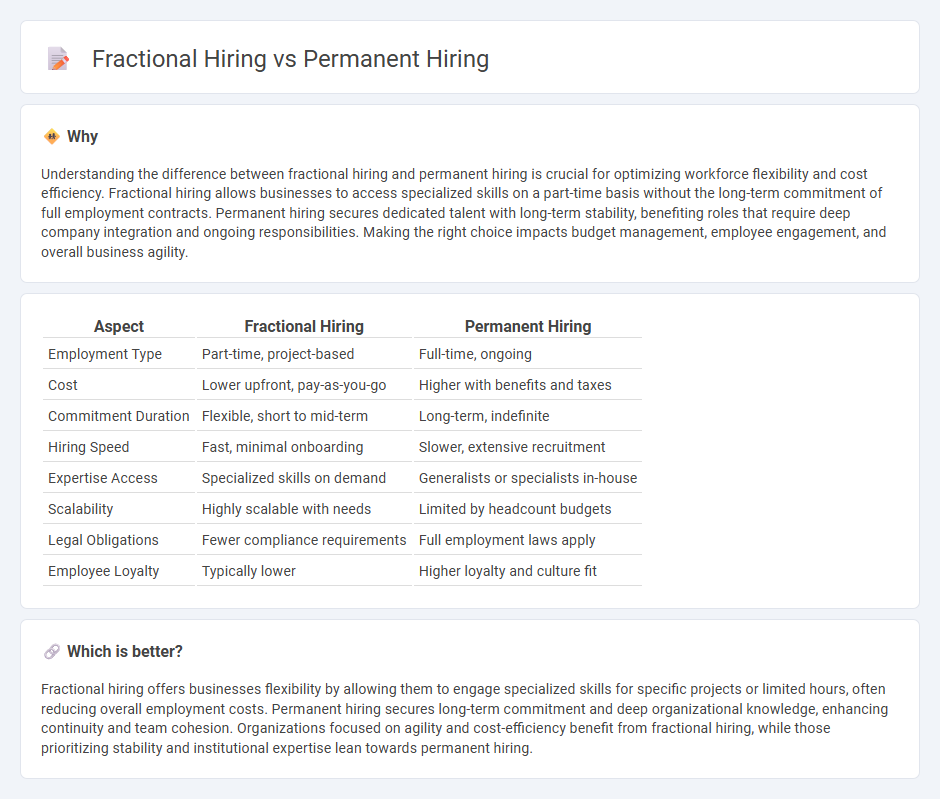
Fractional hiring offers companies scalable access to specialized skills on a part-time basis, reducing overhead costs compared to permanent hiring, which involves full-time commitments and long-term employee benefits. Businesses leveraging fractional talent gain flexibility to meet fluctuating project demands without the financial risks tied to permanent staff. Discover how balancing fractional and permanent hiring strategies can optimize workforce efficiency.
Why it is important
Understanding the difference between fractional hiring and permanent hiring is crucial for optimizing workforce flexibility and cost efficiency. Fractional hiring allows businesses to access specialized skills on a part-time basis without the long-term commitment of full employment contracts. Permanent hiring secures dedicated talent with long-term stability, benefiting roles that require deep company integration and ongoing responsibilities. Making the right choice impacts budget management, employee engagement, and overall business agility.
Comparison Table
| Aspect | Fractional Hiring | Permanent Hiring |
|---|---|---|
| Employment Type | Part-time, project-based | Full-time, ongoing |
| Cost | Lower upfront, pay-as-you-go | Higher with benefits and taxes |
| Commitment Duration | Flexible, short to mid-term | Long-term, indefinite |
| Hiring Speed | Fast, minimal onboarding | Slower, extensive recruitment |
| Expertise Access | Specialized skills on demand | Generalists or specialists in-house |
| Scalability | Highly scalable with needs | Limited by headcount budgets |
| Legal Obligations | Fewer compliance requirements | Full employment laws apply |
| Employee Loyalty | Typically lower | Higher loyalty and culture fit |
Which is better?
Fractional hiring offers businesses flexibility by allowing them to engage specialized skills for specific projects or limited hours, often reducing overall employment costs. Permanent hiring secures long-term commitment and deep organizational knowledge, enhancing continuity and team cohesion. Organizations focused on agility and cost-efficiency benefit from fractional hiring, while those prioritizing stability and institutional expertise lean towards permanent hiring.
Connection
Fractional hiring allows businesses to access specialized skills on a part-time or project basis, complementing permanent hiring by filling immediate or flexible talent needs without long-term commitments. Permanent hiring builds a stable workforce with ongoing roles, while fractional hiring offers scalability and agility in workforce management. Integrating both strategies optimizes resource allocation and supports dynamic business growth.
Key Terms
Full-time Employment
Full-time employment in permanent hiring involves a long-term commitment with consistent hours, comprehensive benefits, and job security, making it ideal for roles requiring deep organizational knowledge and company culture integration. Fractional hiring, on the other hand, offers specialized expertise on a part-time or project basis without the costs associated with full-time salaries and benefits, suiting businesses with fluctuating workloads or specific skill needs. Explore how these hiring strategies affect your talent acquisition to align resources optimally with business goals.
Contractual Work
Permanent hiring involves full-time employees with long-term commitments and benefits, while fractional hiring offers specialized skills on a part-time or project basis, ideal for contractual work requiring flexible resource allocation. Contractual roles benefit from fractional hiring by reducing overhead costs and allowing companies to scale talent according to project demands without long-term obligations. Explore how your business can leverage these hiring models to optimize workforce efficiency and cost-effectiveness.
Flexibility
Permanent hiring offers stability with full-time commitments, providing organizations with dedicated employees aligned to long-term goals. Fractional hiring enhances flexibility by allowing companies to engage experts on a part-time or project basis, optimizing resource allocation and reducing overhead costs. Explore the advantages of flexible workforce strategies to determine the best fit for your business needs.
Source and External Links
Temporary vs. Permanent Employees: Benefits & Disadvantages - Permanent hiring offers increased employee engagement, workforce stability, reduced recruiting burden, and strengthens company culture by keeping employees invested long-term in the organization's goals and values.
Permanent Hiring vs Interim Hiring: How to Make the Right Decision - Permanent hires provide commitment, contribute positively to company culture, solidify skill development within the organization, and enable more effective strategic workforce planning compared to interim employees.
Permanent employment - Wikipedia - Permanent employment involves an ongoing job relationship without a predetermined end date, with employees often receiving benefits and legal protections, and it is considered vital for social stability and workforce quality.
 dowidth.com
dowidth.com